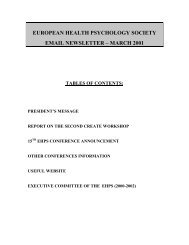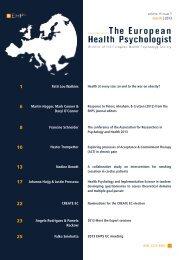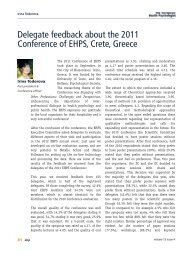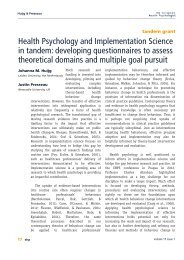Personality, Health Behaviours, Illness Perceptions, Attitudes and S
Personality, Health Behaviours, Illness Perceptions, Attitudes and S
Personality, Health Behaviours, Illness Perceptions, Attitudes and S
You also want an ePaper? Increase the reach of your titles
YUMPU automatically turns print PDFs into web optimized ePapers that Google loves.
15 THE EUROPEAN HEALTH PSYCHOLOGIST Volume 12, June 2010<br />
!<br />
Eamonn Ferguson<br />
original article<br />
A Taxometric Agenda for <strong>Health</strong> Psychology: <strong>Personality</strong>, <strong>Health</strong> <strong>Behaviours</strong>,<br />
<strong>Illness</strong> <strong>Perceptions</strong>, <strong>Attitudes</strong> <strong>and</strong> Symptoms<br />
<strong>Personality</strong> <strong>and</strong> Social Psychology <strong>and</strong> <strong>Health</strong> (PSPH) Group, School of Psychology,<br />
University of Nottingham, Nottingham, NG7 2RD.<br />
An implicit assumption concerning many latent<br />
variables studied within health psychology, (e.g.,<br />
personality, emotions, health behaviours, illness representations,<br />
symptoms), is that they are continuous/<br />
dimensional constructs. However, it is an empirical<br />
question whether or not a latent construct is truly dimensional<br />
(i.e., distributed as a continuous variable,<br />
with individuals varying quantitatively from each other)<br />
or if it is taxonic (i.e., individuals are differentiated into<br />
non-arbitrary groups or categories) (Ruscio, Haslam,<br />
Ruscio, 2006). Simply inspecting distributions, applying<br />
cluster or factor analysis will not answer this question<br />
(Waller & Meehl, 2006; Beauchaine, 2007). However,<br />
Meehl <strong>and</strong> colleagues (see Meehl, 1995; Waller &<br />
Meehl, 2006) developed a suite of statistical procedures,<br />
termed taxometrics, specifically designed to demonstrate<br />
if a latent structure is dimensional or taxonic (see<br />
Meehl, 1995). I will indicate why this question of<br />
dimensionality is not a trivial one, briefly outline the<br />
taxometric method <strong>and</strong> briefly show how it can be applied<br />
to address key questions concerning theory <strong>and</strong><br />
interventions within health psychology.<br />
Dimension or Taxon: A Key Scientific Question<br />
Identifying whether constructs form distinct<br />
taxa (e.g., plants) or vary in terms of quantity (e.g.,<br />
temperature) or degree (e.g., position in a status hierarchy)<br />
is a fundamental basis of science <strong>and</strong> theory building.<br />
Similarly for psychological science knowing<br />
whether a latent construct is dimensional or taxonic has<br />
important theoretical <strong>and</strong> practical/clinical implications<br />
(Ruscio et al., 2006). Explanations for dimensional<br />
models suggest multiple, additive causal factors that<br />
sum to produce quantitative variation (Ruscio et al.,<br />
2006). This implies that clinicians <strong>and</strong> researchers<br />
should utilize the full range of scores for diagnostic <strong>and</strong><br />
research purposes (Widiger & Trull, 2007). A categorical<br />
model needs to explain the discontinuity between<br />
people <strong>and</strong> explanations may include a single causal<br />
factor (e.g., genetic or threshold models) or more complex<br />
interacting systems such as environmental influences<br />
leading to developmental bifurcation (Ruscio et<br />
al., 2006). The basic principle is that the existence of<br />
either dimensional or taxonic model requires a different<br />
theoretical account.<br />
Professor Eamonn Ferguson<br />
Professor of Psychology, <strong>Personality</strong> <strong>and</strong> Social<br />
Psychology <strong>and</strong> <strong>Health</strong> (PSPH) Group, School of<br />
Psychology, University of Nottingham,<br />
Nottingham, UK<br />
The Taxometric Method<br />
Detailed overviews of the taxometric methods<br />
are available elsewhere <strong>and</strong> the reader should refer to<br />
these for details (Beauchaine, 2007; Ruscio et al., 2006;<br />
Ruscio & Ruscio, 2004; Waller & Meehl, 2006). Basically<br />
taxometric procedures require three main steps (1)<br />
identifying valid construct indicators, (2) applying the<br />
appropriate taxometric method <strong>and</strong> (3) interpretation.<br />
Indicators (e.g., items, scales, physiological<br />
responses etc.) are used if they can distinguish cases<br />
(termed taxons) from non-cases (termed complements).<br />
This is usually expressed in terms of a Cohen’s d, with a<br />
value of 1.25 as the minimum cut off (Meehl, 1995).<br />
Good indicators require high item-total correlations <strong>and</strong><br />
have minimum nuisance covariance (correlations<br />
among indicators in putative taxon <strong>and</strong> complement) of<br />
around .30 or less (Meehl, 1995). Indicators should pass<br />
all of these tests.<br />
The basic taxometric technique involves the<br />
indictor variables split into input <strong>and</strong> output variables.<br />
At successive divisions along the input variable either<br />
mean differences either side of a cut (mean above minus<br />
below a cut: MAMBAC), or co-variances (Maximum<br />
Covariance: MAXCOV) or eigenvalues (Maximum Eigenvalues:<br />
MAXEIG) within a cut are computed for the<br />
remaining indicators (called output variables) (Waller &<br />
*Corresponding Author: Eamonn Ferguson; email:eamonn.ferguson@nottingham.ac.uk<br />
www.ehps.net/ehp
THE EUROPEAN HEALTH PSYCHOLOGIST Volume 12, June 2010 16<br />
!<br />
original article<br />
Ferguson (cont'd)<br />
Meehl, 1998; Ruscio et al, 2006). These differences,<br />
covariances or eigenvalues will be at a minimum when<br />
either complement or taxon are present alone <strong>and</strong> at a<br />
maximum when the sample contains equal proportions<br />
of both. MAMBAC is used when there is a minimum of<br />
two indicators, MAXCOV or MAXEIG are used with at<br />
least three indicators. Recently taxometric procedures<br />
have been extended to incorporate factor analytic procedures<br />
known as L-Mode factor analysis (Waller &<br />
Meehl, 1998). Interpreting taxometric analysis involves<br />
inspecting the characteristic shape of the curves, when<br />
divisions are plotted on the x-axis <strong>and</strong> mean differences,<br />
covariance or eigenvalues on the y-axis. For a taxonic<br />
solution the curve will be peaked with MAMBAC <strong>and</strong><br />
either peaked or cusped when MAXCOV/MAXEIG is<br />
used. If the structure is dimensional the curve will be<br />
either flat or concave. To aid interpretation a curve<br />
comparison fit index (CCFI) (Ruscio, 2007; Ruscio,<br />
Ruscio, & Meron, 2007; Ruscio & Marcus, 2007) can<br />
be consulted which varies between 0 <strong>and</strong> 1, with values<br />
greater than .5 indicating a taxonic solution <strong>and</strong> below<br />
.5 a dimensional solution. For any taxometric study<br />
more than one method should be used <strong>and</strong> convergence<br />
across the methods examined.<br />
Taxometrics: An Agenda for <strong>Health</strong> Psychology<br />
Research<br />
There are numerous important roles for<br />
taxometrics within health psychology <strong>and</strong> these are detailed<br />
below.<br />
<strong>Personality</strong>, Diagnosis <strong>and</strong> Prognosis: Can<br />
personality traits be used as diagnostic <strong>and</strong> prognostic<br />
constructs, with definable cutoff scores Type-D<br />
personality has become defined as one such categorical<br />
risk factor in cardiovascular disease (Denollet, 1998).<br />
However, the cut-offs for Type D are arbitrary (see Ferguson<br />
et al., 2009). Apart form the dangers of treating a<br />
continuous measure as if it were taxonic, a major danger<br />
of using arbitrary cut-offs in this context is misdiagnosis<br />
of cases as non-cases <strong>and</strong> visa-versa. The<br />
taxometrics of Type D have recently been reported <strong>and</strong><br />
show that it is in fact dimensional <strong>and</strong> not taxonic (Ferguson<br />
et al., 2009). As such, there are concerns about<br />
using Type D as a categorical risk factor, based on arbitrary<br />
cut-offs when in fact it is dimensional. However, it<br />
is appropriate to draw distinctions within a dimensional<br />
construct as long as these are systematic <strong>and</strong> empirically<br />
justifiable (Ruscio et al., 2006) via identifying inflection<br />
points (Kessler, 2002) or the cross-over points<br />
for sensitivity <strong>and</strong> specificity (Ferguson, 2009).<br />
Fortunately taxometric analyses have been applied<br />
to many traits regularly used in health psychology<br />
<strong>and</strong> a large number are dimensional: (1) alexithymia<br />
(Parker, Keefer, Taylor & Bagby, 2008), (2) health<br />
anxiety (Ferguson 2009), (3) Type-D (Ferguson et al.,<br />
2009), adult attachment styles, impulsivity (see Ruscio<br />
et al., 2006), whereas a number are taxonic including<br />
Type A, self-monitoring, <strong>and</strong> impression management<br />
(see Ruscio et al., 2006 for a review).<br />
<strong>Health</strong> <strong>Behaviours</strong>, illness representations <strong>and</strong><br />
symptoms: Indices of unhealthy behaviour (e.g., summing<br />
the extent to which people smoke, drink alcohol,<br />
take drugs, have a poor diet; Kendzor et al., 2008) or<br />
the extent to which people report emotions associated<br />
with health behaviours (Kiviniemi, Voss-Humke &<br />
Seifert, 2007) are often summed to form a single continuum.<br />
However, it may be that these types of index<br />
are taxonic; that is a group exists, who have unusually<br />
strong positive emotions associated with negative health<br />
behaviours. If indeed these types of measure are taxonic<br />
this has profound implications for the type of theoretical<br />
models that might be used to explain unhealthy behaviours<br />
<strong>and</strong> in developing interventions. If a taxon is uncovered<br />
for example, it would be useful to assign people<br />
to taxon <strong>and</strong> complement (see Ruscio, 2009), <strong>and</strong><br />
explore: (1) if the taxonic group membership is stable<br />
over time (is trait like), (2) if there are differential predictors,<br />
<strong>and</strong> (3) models that suggest developmental bifurcation.<br />
It would also suggest that this group would<br />
require focused interventions <strong>and</strong> indicate (based on<br />
cutoff <strong>and</strong> base rate information from the taxometrici<br />
procedure) who to target the intervention at. As such,<br />
the status of health behaviours as a focus of intervention<br />
<strong>and</strong> a predictor would change.<br />
Similar arguments can be applied to other<br />
widely used latent constructs in health psychology. For<br />
example, illness representations are treated as continuous<br />
<strong>and</strong> taxometric methods could be applied to explore<br />
if any of the ‘dimensions’ of illness representations are<br />
taxonic <strong>and</strong> if this is the case across different illnesses.<br />
Similarly for symptom reporting is there a taxonic<br />
group that represents people who tend to over-report<br />
symptoms Indeed Ferguson et al (2009) have suggested<br />
such a possibility in terms of developing<br />
taxometric approaches within psychosomatic medicine<br />
to examine if levels of abnormal illness behaviour <strong>and</strong><br />
symptom reporting (e.g., Chronic Fatigue Syndrome)<br />
form a distinguishable diagnostic category. Taxometric<br />
methods are now starting to be applied in the field of<br />
attitudes research <strong>and</strong> similar approaches could be taken<br />
with respect to attitudes research in health psychology<br />
(e.g., Denson, Iyer & Livkel, 2009). Finally, it should<br />
be noted that taxometrics can be applied to all types of<br />
data including physiological recording: For example,<br />
www.ehps.net/ehp
!<br />
17 THE EUROPEAN HEALTH PSYCHOLOGIST Volume 12, June 2010<br />
original article<br />
Ferguson (cont'd)<br />
are there different groups of physiological responders to<br />
stress<br />
In conclusion a taxometric approach to health<br />
psychology research <strong>and</strong> practice would help to delineate<br />
the nature of many key constructs used <strong>and</strong> help further<br />
refine <strong>and</strong> develop theory <strong>and</strong> practice.<br />
Widiger, T. A., & Trull, T. J. (2007). Plate tectonics in the<br />
classification of personality disorder. American<br />
Psychologist, 62, 71-83.<br />
References<br />
Beauchaine, T. P. (2007). A brief taxometric primer. Journal of<br />
Clinical <strong>and</strong> Child Adolescent Psychology, 36, 654-676.<br />
Denollet, J. (1998). <strong>Personality</strong> <strong>and</strong> risk of cancer in men with<br />
coronary heart disease. Psychological Medicine, 28,<br />
991-995.<br />
Denson, T. F., Iyer, R., & Livkel, B. (2009). Racist or racism<br />
Taxometric support for a dimensional latent structure to<br />
explicit prejudice. Group Processes <strong>and</strong> Intergroup<br />
Relations, 13, 113-128.<br />
Ferguson, E. (2009). A taxometric analysis of health anxiety.<br />
Psychological Medicine, 39, 277-285.<br />
Ferguson, E., Williams. L., O’Connor, R., Howard, S., Hughes, B.<br />
M., Johnston D. W., et al. (2009). A Taxometric Analysis<br />
of Type-D <strong>Personality</strong>. Psychosomatic Medicine, 71(9),<br />
981-986<br />
Kendzor, D. E., Cofta-Woerpel, L. M., Mazas, C., Li, Y., Vidrine, J.<br />
I., Reitzrl, L. R., et al. (2008). Socioeconomic status,<br />
negative affect <strong>and</strong> modifiable cancer risk factors in<br />
African-American smokers. Cancer Epidemiology,<br />
Biomarkers <strong>and</strong> Prevention, 17(10), 2546-2554.<br />
Kessler, R. C. (2002). Epidemiology perspectives for the<br />
development of future diagnostic systems. Psychopathology,<br />
35, 158-161.<br />
Kiviniemi, M. T., Voss-Humke, A. M., & Seifert, A. L. (2007). How<br />
do I feel about the behavior The interplay of affective<br />
associations with behaviors <strong>and</strong> cognitive beliefs as<br />
influences on physical activity <strong>and</strong> behaviour. <strong>Health</strong><br />
Psychology, 26, 152-158.<br />
Meehl, P. E. (1995). Bootstrap taxometrics: Solving the<br />
classification problem in psychopathology. American<br />
Psychologist, 50, 266-275.<br />
Parker, J. D. A, Keefer K. V., Taylor G. J., & Bagby R. M. (2008).<br />
Latent structure of the alexithymia construct: A taxometric<br />
investigation. Psychological Assessment, 20, 385-396.<br />
Ruscio, J. (2007). Taxometric analysis: An empirically grounded<br />
approach to implementing the method. Criminal Justice<br />
<strong>and</strong> Behavior, 34, 1588-1622.<br />
Ruscio, J. (2009). Assigning cases to groups using taxometric<br />
results. Assessment, 16, 55-70.<br />
Ruscio J., Haslam N., & Ruscio A. M. (2006). Introduction to the<br />
taxometric method: A practical guide. Mahwah, NJ:<br />
Lawrence Erlbaum Associates.<br />
Ruscio, J., & Marcus, D. K. (2007). Detecting small taxa using<br />
simulated comparison data: A reanalysis of Beach, Amir,<br />
<strong>and</strong> Bau’s (2005) data. Psychological Assessment, 9,<br />
241-46.<br />
Ruscio, J., Ruscio, A. M., & Meron M. (2007). Applying the<br />
bootstrap to taxometric analysis: Generating empirical<br />
sampling distributions to help interpret results.<br />
Multivariate Behavior Research, 42, 349-386.<br />
Ruscio, J., & Ruscio A. M. (2004) A nontechincal introduction to the<br />
taxometric method. Underst<strong>and</strong>ing Statistics, 3, 151-194.<br />
Waller, N. G., & Meehl P. E. (1998). Multivariate taxometric<br />
procedures. Thous<strong>and</strong> Oaks, CA: Sage.<br />
www.ehps.net/ehp









